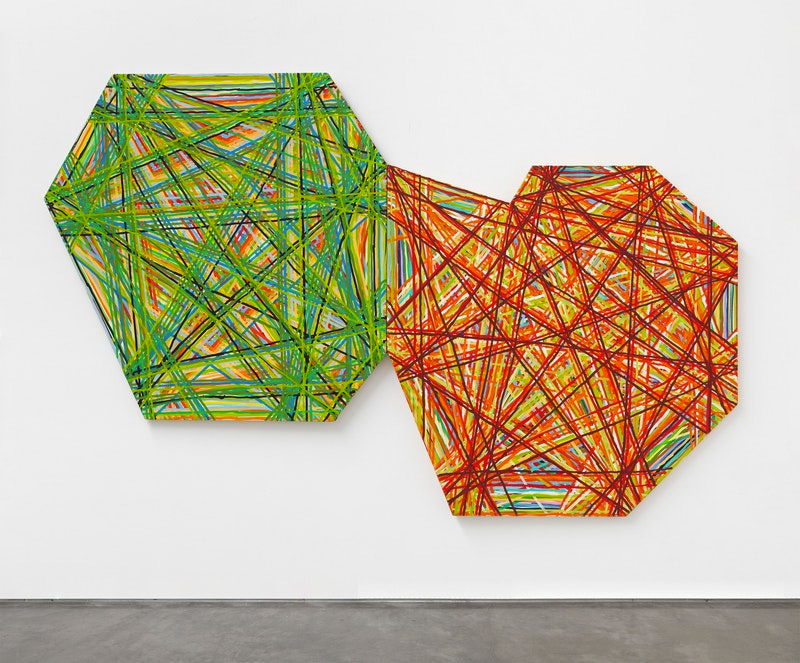
- Source: THE BROOKLYN RAIL
- Author: Alfred Mac Adam
- Date: JULY 01, 2019
- Format: PRINT AND DIGITAL
cart, horse, cart
Curated by Michael Goodson and Anna Stothart

Installation view: cart, horse, cart, Lehmann Maupin, New York, 2019. Courtesy the artists and Lehmann Maupin, New York, Hong Kong, and Seoul. Photo: Matthew Herrmann.
Cart, horse, cart brings together fifteen artists of different generations, eight women and seven men in a brilliant redefinition of the banal “summer group show” that galleries offer to fill in so-called dead, off-season time. This exhibition proves, first, that nowadays there is no down time in the art world and, second, that abstraction is not only not dead but has also risen phoenix-like to new heights in the twenty-first century.
Think of this show, spread out over two venues allowing viewers to experience each work without crowding, as an anthology of possibilities: painting, painting on the wall, painting off the wall, painting as sculpture. A single thread unites this diversity: structure taken as a lost utopia. Here, structure or geometric form is a dissolving but still present lifeline: if absolute abstract freedom opens the door to the abyss, the artist must recognize, if only with longing, limits.

Diana Al-Hadid, Vesuviusev, 2018. Steel, fiberglass, polymer gypsum, plaster, gold leaf, copper leaf, pigment, 4 parts, each 63 x 54 inches. Courtesy the artist and Marianne Boesky Gallery, New York and Aspen. © Diana Al-Hadid. Photo credit: Object Studies.
The artists assembled here—Lehmann Maupin gallery artists like McArthur Binion, Angel Otero, and Lari Pittman, older artists like Jennifer Bartlett, Beverly Fishman, Joanne Greenbaum, or Terry Winters, and newer faces such as Sarah Cain, Molly Zuckerman-Hartung, and Diana Al-Hadid—do not constitute a school or a movement but a cross-section. So the range of time encompassed by the show—the earliest work being Jennifer Bartlett’s 1993 Alphabet Five—is not relevant as the point of departure for a narrative or history. These works are all contemporary in the sense that they partake of the knowledge that respect for lost limits opens the door to renewal.
Molly Zuckerman-Hartung’s Adulterate (2013–2019) and Diana Al-Hadid’s Vesuviusev (2018) stand as tutelary icons. Zuckerman-Hartung took six years to produce her massive (95 × 167 × 12) collage. It is a painting, an assemblage, and a sculpture that flows off the wall onto the gallery floor. It is not disintegrating, but, to the contrary, building on its own resources. The title sounds negative, but in this context the artist acknowledges that the path to creation involves impurity, deviation, and combining elements ordinarily kept separate. (The same esthetic prevails in Angel Otero’s superb Casting Light (2019), an amalgamation of oil skins on fabric, as if the artist had literally destroyed work to create new work.)

Angel Otero, A False Spring, 2016. Oil paint and fabric collaged on canvas, 96 x 145.5 inches. Courtesy the artist and Lehmann Maupin, New York, Hong Kong, and Seoul.
Diana Al-Hadid also makes a large statement. Her wall piece is composed of four parts, each on 63 × 54. It is as if the work’s origin was a rectangular mass the artist deliberately smashed, sacrificing geometric control in favor of energy release. There is something Anselm Kiefer-like about this piece, with its volcanic eruption of pigment. Not for nothing is the name Vesuvius embedded in its title: to make something new, some old order must be smashed.
Cecily Brown too pulls out all the stops in her magnificent All Nights Are Days, an oil on linen from 2019. Brown here appears to use the language of Abstract Expressionism, and the turbulent surface she creates with its swirling, illusory depths is definitely her rewrite of the supposedly masculine energy of action painting. But if we look closely, we see that there is here a gesture toward control in the black paint she uses as a framing device. Brown’s disorder, we discover, is premeditated, not anarchic.

Jennifer Bartlett, Untitled, 2001-2002. Oil on canvas, 58 x 92 inches. © Jennifer Bartlett. Courtesy Marianne Boesky Gallery, New York and Aspen, Paula Cooper Gallery, New York, and The Jennifer Bartlett 2013 Trust.
On a more intimate scale, Beverly Fishman’s two works, Untitled (Anxiety, ADHD, Pain) (2019) and Untitled (Opiod Addiction, One Empty Tablet)(2019) are essentially painted wall sculpture. Despite their frightening parenthetical titles, these two pieces are exercises in the slow disclosure of color pleasure within prescribed structures. So the geometry of the form is nullified by pigment, but we must gaze steadily at these pieces and allow them to open themselves slowly.
The dialectical relationship between structure and chaos dominates many works here. Jennifer Bartlett’s Untitled (2001–2002) could be read as the collision of two highly organized cells or the splitting apart of two cells that realize they no longer have anything in common. The binary opposition, a kind of paradoxical dynamic stasis, summarizes much of the energy expressed in the entire show. Joanne Greenbaum and Sarah Cain, each represented by four works, also capture the struggle between a structure that can no longer hold together and ensuing chaos.
Anyone interested in experiencing the possibilities of abstraction in our century should see this splendid brigade of works co-organized by curator Michael Goodson and Lehmann Maupin Curatorial Director Anna Stothart.

